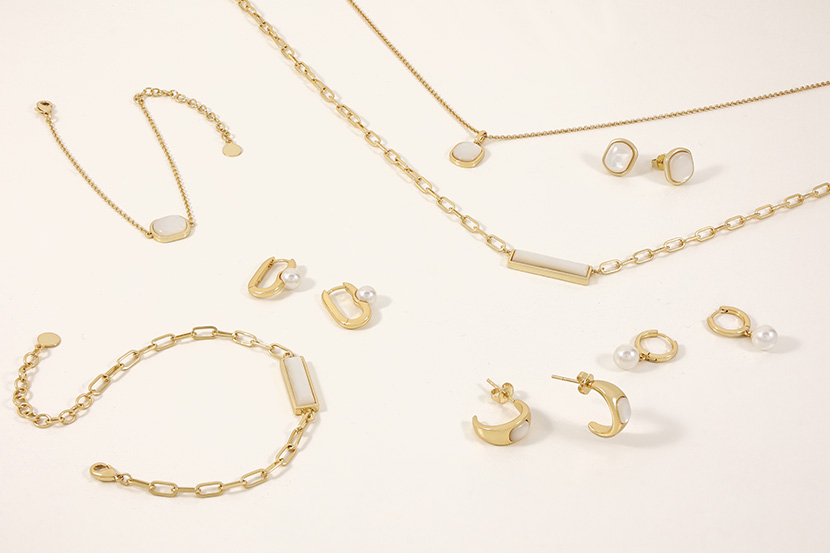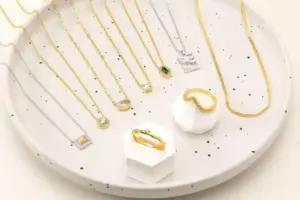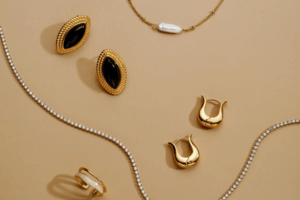Gold jewelry can tarnish—but not all of it does. Gold jewelry that doesn’t tarnish includes solid gold (14K and higher, ideally 18K+), gold-filled with at least 5% gold by weight, and PVD-coated stainless steel. These options resist oxidation and keep their shine longer because of their high gold content or durable bonded layer.
In this guide, we’ll explain what gold jewelry doesn’t tarnish, best tarnish free options, and how to pick the best pieces for lasting beauty.
Quick Comparison Table: Tarnish Resistance by Jewelry Type
| Jewelry Type | Composition | Tarnish Resistance | Lifespan | Shower Safe | Pool Safe | Cost Level |
| Solid Gold (14K–24K) | ≥14K (58.3% gold), 18K+ (75% gold) | ⭐⭐⭐⭐⭐ | For years | ✅ Yes | ⚠️ Wipe & Dry | $$$$ |
| Gold-Filled | Brass/silver base + ≥5% gold by weight | ⭐⭐⭐⭐ | 3-5 years | ✅ Yes | ⚠️ Wipe & Dry | $$$ |
| Gold Vermeil | Sterling silver base + ≥2.5 µm gold layer | ⭐⭐⭐ | 1–2 years | ✅ Yes | ⚠️ Wipe & Dry | $$$ |
| PVD-Coated | SS + 0.03-0.08 µm gold layer | ⭐⭐⭐⭐ | At least 2 years | ✅ Yes | ✅ Wipe & Dry | $$ |
| Gold-Plated (Standard) | Base metal + common 0.05 µm gold layer | ⭐ | 6–12 months | ⚠️ Limited | ❌ No | $ |
What Type of Gold Jewelry Doesn’t Tarnish?
The two major types of gold jewelry you can depend not to tarnish no matter the situation they are exposed to, are solid gold and gold filled. They are made with a higher percentage of gold, making them less likely to react to oxygen, water, or chemicals. Another affordable gold jewelry that won’t tarnish easily is PVD gold coating jewelry, which is also among the popular types of waterproof gold jewelry for long-lasting shine.
Solid Gold
Made of gold but in different gold purities, such as 14K and 18K solid gold jewelry, or 24K (which is 100% gold). Ordinarily, gold is a noble metal, meaning it doesn’t tarnish like other metals that cannot survive against oxygen, moisture, and chemicals. Even when solid gold becomes dull or scratched due to carelessness, it can easily be polished to restore its shine and brilliance.
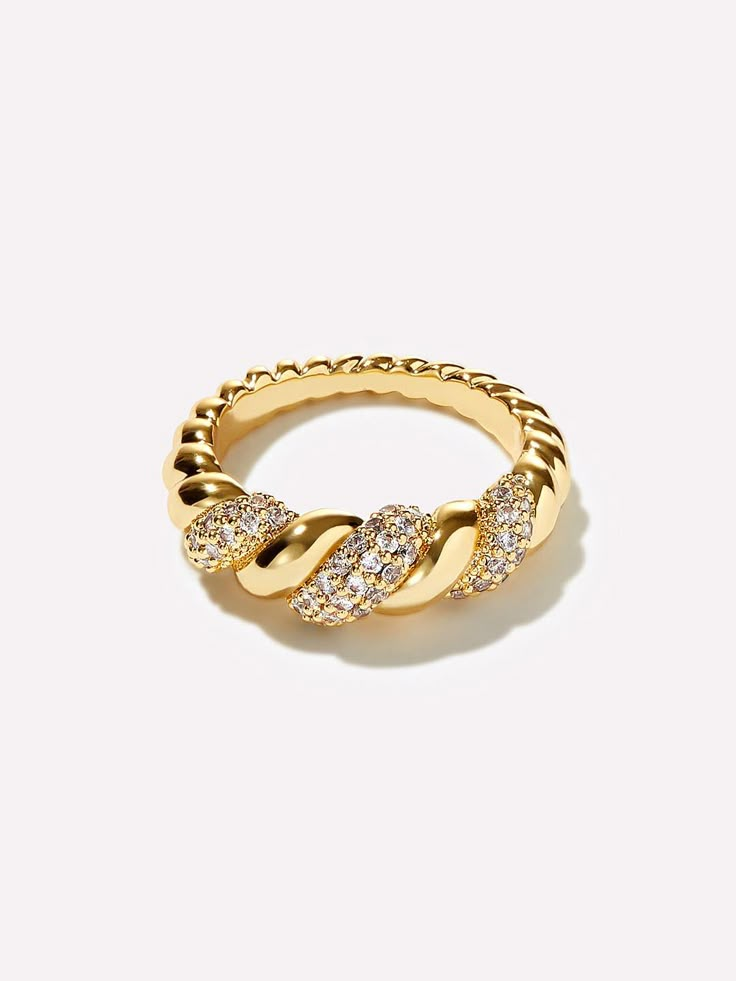
Gold Filled
Gold filled jewelry is an affordable version of solid gold. It involves bonding a thick layer of gold to a base metal, but offering the same durability and anti-tarnishing properties as solid gold jewelry. According to the U.S Federal Trade Commission (FTC), for a piece to be labeled as gold-filled, the gold layer must constitute at least 5% (1/20th) of the jewelry’s total weight, ensuring both quality and longevity.
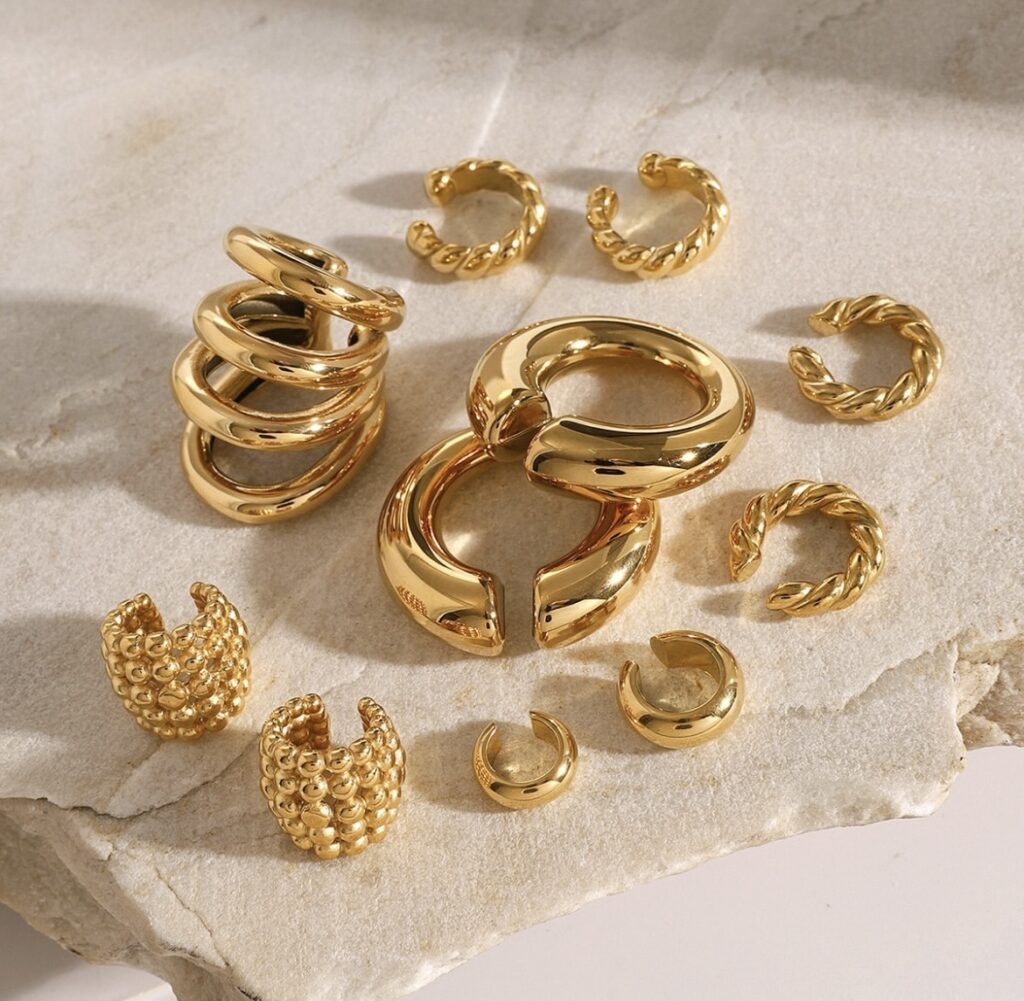
PVD Gold Plated Jewelry
With a gold layer of 0.03-0.08 microns, jewelry coated using PVD (Physical Vapor Deposition) technology offers a more durable, long-lasting finish than traditional gold plating. PVD gold plated jewelry is highly resistant to scratches, fading, and tarnish, making it ideal for those seeking waterproof tarnish free gold jewelry that holds up well with everyday use.

What Other Jewelry Metal Does Not Tarnish?
While gold is a top choice, several other metals are naturally tarnish-resistant, providing more options for your jewelry collection.
Rhodium-Plated Sterling Silver
Does sterling silver tarnish? Yes, sterling silver without coating tarnishes quickly when exposed to air, moisture, or chemicals.
So, what type of silver doesn’t tarnish? Sterling silver with proper plating, such as rhodium plating, forms a protective barrier and resists tarnish effectively, keeping its shine and luster longer while still maintaining the beauty of genuine silver. For a detailed comparison, see our guide on sterling silver vs rhodium-plated sterling silver.
Stainless Steel
Stainless steel is an alloy that is well-known for its exceptional strength and resistance to rust and tarnish. In fact, it’s one of the few tarnish-free metals available. Often used as the base for PVD gold coating, stainless steel jewelry is durable, affordable, and hypoallergenic—making it one of the most reliable types of waterproof jewelry for everyday wear.
Palladium
Palladium is a member of the platinum family and shares many of its properties, including a natural white luster and resistance to tarnish. Palladium is usually added to make jewelry stronger and harder. It is a popular choice for jewelry due to its anti-tarnish and hypoallergenic properties.
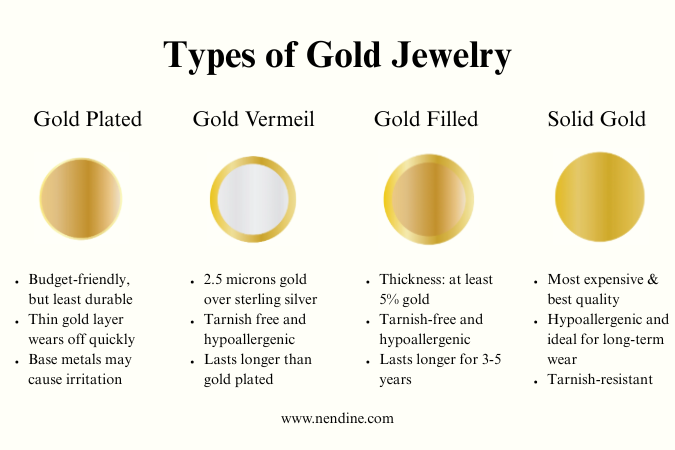
Common Gold Jewelry Types
Explained below are the most popular types of gold jewelry on the market. If you’re wondering how they compare, check out our full guide on Gold Filled vs. Gold Vermeil vs. Gold Plating:
Gold Plated Jewelry
It’s made from bonding a thin layer of gold onto a base metal (copper, brass, or nickel). It’s a low-quality gold jewelry that tarnishes quickly, as the applied gold layer is usually 0.05 microns.
Gold Vermeil Jewelry
This is an upgraded version of gold plated jewelry, with thicker gold layer and better durability. For gold vermeil jewelry, sterling silver is used as the base metal and a minimum of 2.5 microns of gold is applied onto it.
Gold-Filled Jewelry
This involves mechanically bonding a very thick layer of gold to the base metal (copper, brass, or nickel). The bonded gold layer must be at least 5% of the jewelry’s total weight.
Solid Gold Jewelry
Also known as 24K gold, this type of jewelry is made of pure gold. However, pure gold is too soft and might not be able to hold its shape over time. Hence, they are alloyed with a small percentage of stronger metals, like copper for improved hardness.
Best Tarnish-Free Gold Jewelry Options
The most reliable tarnish-free options are solid gold and gold-filled jewelry.
- Solid Gold (14K, 18K, 24K)
Naturally resistant to tarnish, solid gold maintains its shine for decades with proper care. The higher the karat, the purer the gold—and the lower the tarnish risk.
- Gold-Filled Jewelry
Made by bonding a thick layer of gold to a base metal, gold-filled pieces offer strong tarnish resistance and long-lasting shine—at a fraction of the cost of solid gold.
Why Does Jewelry Tarnish?
Tarnishing is a chemical process called oxidation, where metal alloys react with environmental elements. The primary factors that cause tarnishing are:
- Alloy Metal: Most gold jewelry is an alloy mixed with metals like copper, silver, or nickel. These metals are what actually tarnish when exposed to air, water, and other chemicals.
- Chemicals: Everyday products like perfumes, lotions, cosmetics, and household cleaners contain chemical substances that can accelerate tarnishing when they come into direct contact with jewelry.
- Water: While pure water doesn’t cause tarnish, elements in water like chlorine can trigger oxidation in jewelry alloys. This is a key reason why jewelry may tarnish if worn in pools.
- Sweat: Human sweat contains acids and chemicals that can cause the alloy metals in gold jewelry to tarnish, especially without regular cleaning.
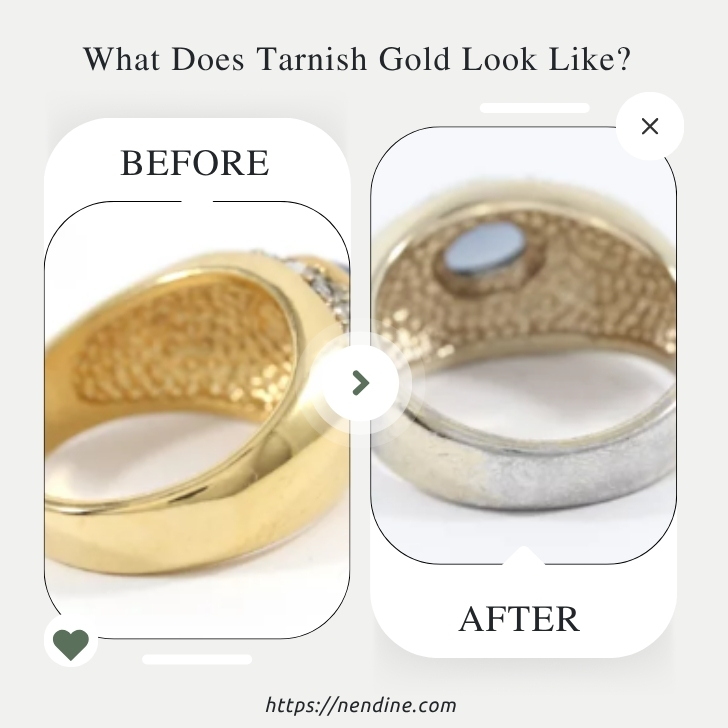
What Does Tarnish Gold Look Like?
Tarnished gold jewelry may appear dull, scratched, or discolored. Common signs include:
- Surface Scratches: Everyday wear can cause fine abrasions that reduce the shine and smoothness of the metal.
- Darkening or Black Spots: Lower karat gold, especially those mixed with silver or copper, can oxidize and develop black areas when exposed to air and moisture.
- Yellowish Tint: Over time, gold jewelry—especially below 18K—can take on a deeper yellow hue due to the oxidation of alloy metals.
- Green Discoloration: Rarely, if the jewelry contains copper or brass alloys, it may react with skin, moisture, or acids and turn slightly green.
What Does Tarnish Free Gold Jewelry Mean?
Tarnish free jewelry meaning is defined with specific properties, such as anti-scratch, waterproof, sweat resistance, sunscreen resistance, and skincare resistance. They are further explained below:
Anti-scratch:
Tarnish-free gold jewelry is designed with a protective layer that improves its strength and makes it highly-resistant to scratches. The anti-scratch characteristic prevents abrasions that may result in the dullness of your fine pieces.
Waterproof:
Tarnish-free gold jewelry supports safe use in every condition, including wet environments. It won’t fade or lose its shine when exposed to water like during bathing, swimming, rainy climate, etc.
Sweat Resistance:
Sweat are wastes from the body that contains chemicals like salt and acids, which are dangerous to jewelry metals. Tarnish-free gold jewelry is treated with protective layers, ensuring it doesn’t corrode even when you wear it for intense workouts or in hot environments.
Sunscreen Resistance:
Usually sunscreens are made with strong chemicals that repel the impact of sun on your skin. These chemicals also react with any metallic object you wear, including gold jewelry. But tarnish-free gold jewelry is manufactured to resist these chemicals, making it suitable for outdoor activities.
Skincare Resistance:
Many skincare products, like lotions, perfumes, and soaps, are produced with ingredients that are harsh and capable of degrading your jewelry. However, tarnish-free gold jewelry is specially made with these effects in consideration, allowing you to wear your sparkling pieces without worries about discoloring.
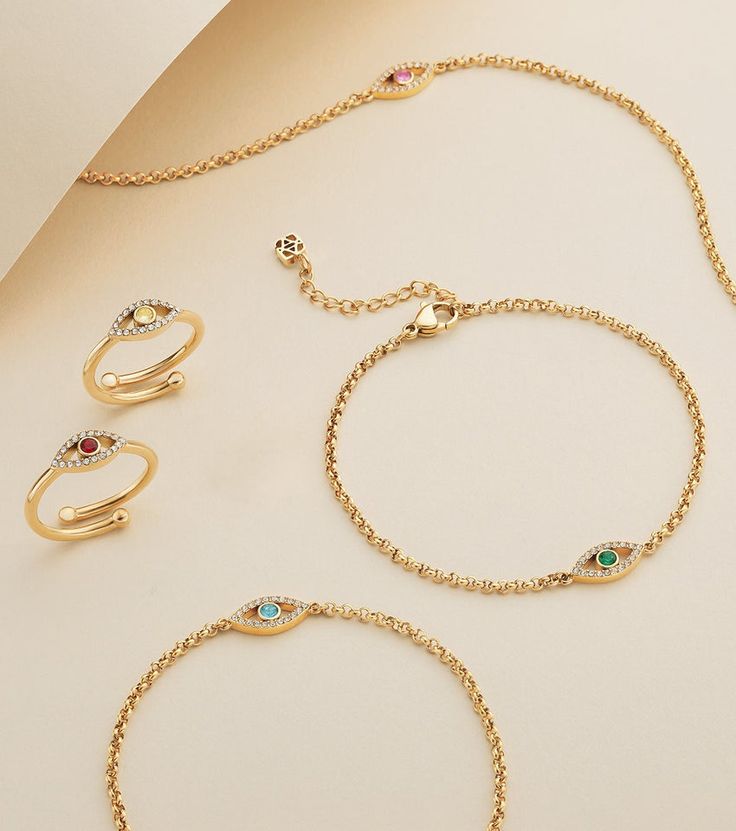
Can You Shower With Gold Jewelry? What Gold Can You Wear in the Shower?
Yes, but caution is key. Showering with gold jewelry—especially 14K or higher solid gold and gold-filled—is generally safe. However, several factors can still dull its shine:
- Hard water (rich in minerals like calcium and magnesium) can contribute to tarnish buildup.
- Soap and shampoo may leave residue that makes jewelry appear cloudy or less lustrous.
💡 Tip: Rinse your jewelry after showering and dry it thoroughly to preserve its brilliance.
Can I Wear Gold Jewelry in the Pool?
Technically, yes—but it depends. While solid gold and gold-filled jewelry are generally resistant to tarnish, chlorinated pool water can still cause damage over time.
- High chlorine levels may react with metal alloys, leading to discoloration or dullness.
- Long exposure increases the risk—occasional dips are safer than extended swimming.
- Higher purity gold (18K or 24K) has fewer reactive metals and is less likely to tarnish.
💡 Tip: If you plan to swim often, opt for jewelry you can swim in such as high-purity solid gold or remove your jewelry beforehand.
Does Gold Tarnish in Salt Water?
Salt water can accelerate tarnishing in gold jewelry, especially if it’s not pure 24k gold. The chlorine and minerals in seawater react with alloy metals like copper or silver, causing discoloration. Forwaterproof tarnish-free gold jewelry, opt for pieces of higher purity gold jewelry like 18K and above and coated with a protective layer like e-coating.
Inexpensive Gold Jewelry That Won’t Tarnish
If you’re looking for affordable gold jewelry that doesn’t tarnish easily, consider PVD gold coated stainless steel jewelry, which offers excellent color retention and scratch resistance at a low cost. Brass coated with 2.5 microns of 18K gold, silver coated with 1.5 microns of 18K gold are also great alternatives. These combinations also offer 1-2 years of color retention, similar to how long gold vermeil last, providing a cost-effective solution without compromising on quality.
Does Gold Vermeil Jewelry Tarnish?
Yes, but only higher grades of gold vermeil jewelry are non-tarnishing. We recommend 14K and above gold vermeil jewelry. They contain higher gold content, making them more durable and capable of withstanding everyday wear and tear.
Does 14k Gold Tarnish?
Yes, 14K gold can tarnish over time. It contains 58.3% pure gold and 41.7% other metals like copper and silver, which can oxidize and lead to tarnishing. The same applies to rose gold jewelry, since its warm color also comes from a higher copper content. Regular cleaning and proper storage can help maintain its shine.
Does 18k Gold Tarnish?
18K gold, containing 75% pure gold, is less prone to tarnishing compared to 14K gold. However, the remaining 25% of other metals can still oxidize, especially with exposure to moisture and chemicals. Proper care is essential to preserve its appearance.
Key Takeaway
Tarnish-free gold jewelry is a great investment for individuals who love to experience the beauty of gold at all times without worrying about any damaging elements. There are 2 types of gold jewelry you can trust to be tarnish-free: solid gold and gold-filled. Do well to contact a sustainable jewelry manufacturer to get pieces that will remain shiny and beautiful for a lifetime.
